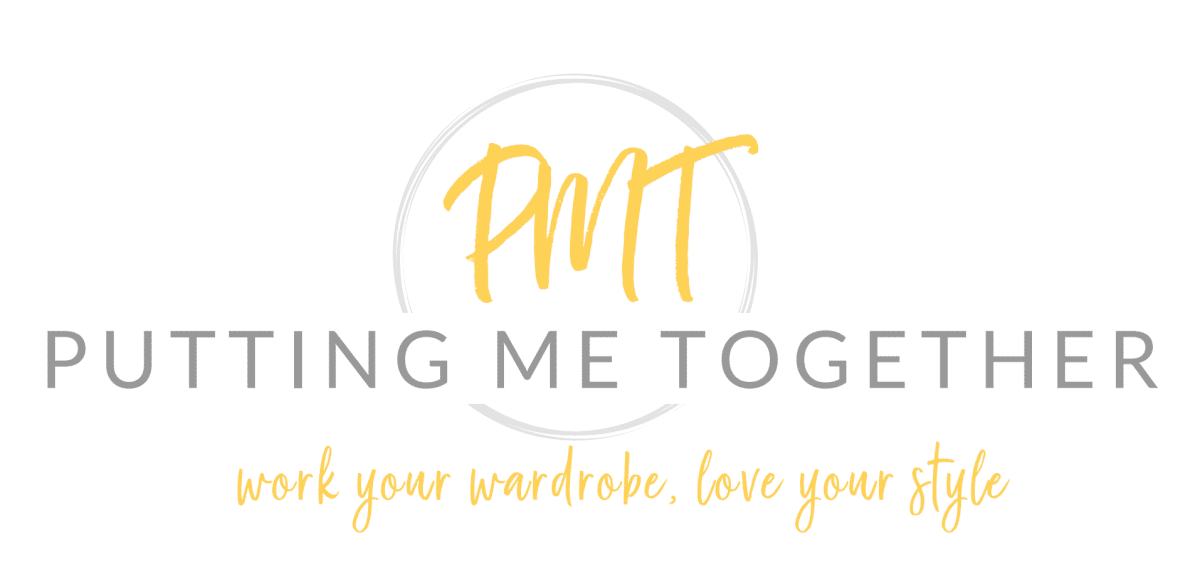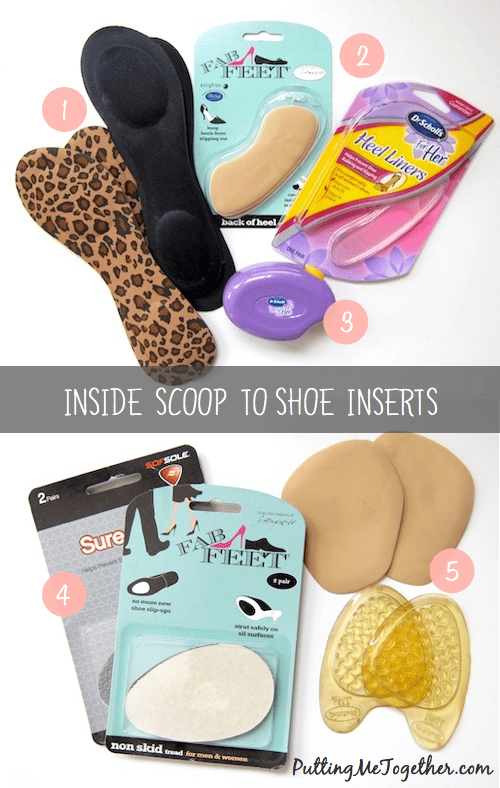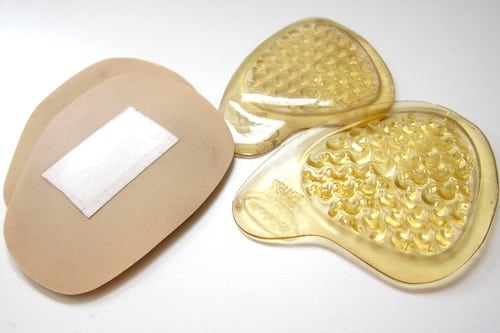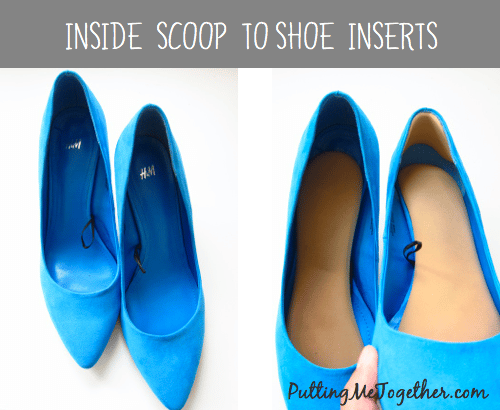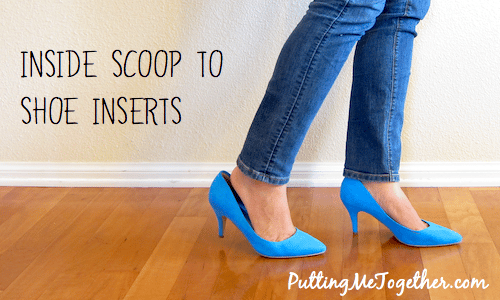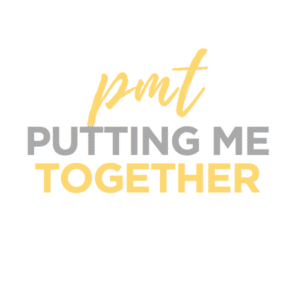Alright, people! A few months ago I mentioned shoe inserts in a post which seemed to spark curiosity in a bunch of you. So, FINALLY, here is the (maybe not so exciting) insider’s peek into my shoes.
Let me start by saying that I don’t *really* know if I know what I’m doing…but I’m doing it. Haha. Everything that I’m telling you has been figured out by experimenting and trial and error. Here goes!
Above are the types of inserts I use, though there are plenty more that exist in the world. As you can see, there is both different types of inserts and different brands, and each brand has different textures and thicknesses to work with. Let’s start by first talking about types of inserts and briefly about their function, then talk about brands. Then we can talk more about how to choose which kind to use.
Types of Inserts
Based off the picture above (and this may not be the official terminology):
- Insoles. Lines the bottom of your shoe and provides a little extra cushion. These can come with extra padding on the ball and heel as shown above, or with heavy arch support, or as an even/level padding.
- Heel liners. Lines the back of the inside of your shoe (topline) to improve grip or fit.
- Rub relief strips (pack of 4). Small strips of padded tape to place anywhere your shoe is rubbing you painfully to provide a cushion.
- Non-skid tread. Placed on outer sole of shoe under ball of foot to prevent slipping and improve traction.
- Ball of foot cushions. Lines inside of shoe where ball of foot goes for focused cushioning.
Brands
I’ve really only tried two brands, which are the two I see at Target. (Go figure.) As you can see in the pictures, I mostly use Dr. Scholl’s for Her and Fab Feet. They can also be found on Amazon. But even if Target isn’t accessible in your neck of the woods hopefully you can just take note of how brands can differ in a general sense so that when you search through the brands that are available to you you’ll have a better idea of what to look for.
Dr. Scholl’s for Her
You can see Dr. Scholl’s for Her products in items 1, 2, 3, and 5 (the gel ones) above. The characteristics and some pros for these are:
- both normal cloth texture or gel texture available
- gel has great padding
- gel texture provides great grip
- sticky adhesive on the gel texture allows you to reuse the inserts on other shoes – you can wash with soap and warm water to restore stickiness and reuse (love that!)
- on thicker end of spectrum regarding padding
Fab Feet
You can see these products in 2, 4, and 5 (beige).
- on thinner side of padding spectrum
- usually adhesive is one small rectangle
- have lots of colors and designs
Comparison
Here’s a side by side of the texture of the two brands. On the right, the bottom gel insert is flipped bottom up so that you can see the texture of the sticky adhesive. The entire platform is sticky, and it has those curly ridges for more grip.
The main overarching differences I’ve noticed between the two:
- Fab Feet tends to be thinner than Dr. Scholl’s. I’ve found this true for insoles, ball of foot cushions, and heel liners.
- Adhesive on Fab Feet only covers a small square while Dr. Scholl’s adhesive (for gel products only) covers entire insert. However, I should mention that the adhesive of the Dr. Scholl’s insoles in #1 above is like the Fab Feet adhesive–just a rectangular strip down the entire thing.
- Dr. Scholl’s gel inserts are reusable.
- People with sweaty feet might not enjoy the gel inserts. However, Dr. Scholl’s also has non-gel.
- Dr. Scholl’s tends to be more expensive. Especially the gel stuff. (But you can get them in multipacks on Amazon for a little cheaper.)
- Both come in a variety of colors (beige, clear, black, printed).
Uses
Okay, now the big question–how do you use each of these? Well, for me since those gel ones are reusable it’s kind of been by testing out the different types I have on hand–without using the adhesive–and seeing what works. But here’s what I tend to do…
Usually anytime I use a shoe insert it is either to:
- make my shoes more comfortable
- help my shoes fit better
- both of the above
Whenever I decide to buy the shoe I have to factor in whether or not I’m going to need inserts and if I have enough room for them. Obviously if the shoe is already snug, then inserts aren’t going to be helpful because they’ll squish your feet more and I’ll pass on buying the shoes.
These are the before and after pics of my blue
H&M pumps. H&M does not necessarily make the comfiest shoes, but they’re not terrible either. However, inserts can work wonders on a shoe. Here I used both Fab Feet insoles and heel liners.
Insoles and Ball of Foot Cushions
I use these when a shoe lacks cushioning to help me endure longer periods in heels. I tend not to need these in flats, but some of my friends still do, or they use ones with arch support.
Type – I don’t have it down to a science for when I use insoles versus just ball of foot cushions. Sometimes I need cushioning for my entire foot, and sometimes I only need it at the balls of my feet. Sometimes a full insole will make the rest of the shoe fit weird and I need to opt for just a ball of foot cushion. Like I said, it’s a lot of testing different options I have on hand.
Brand / Thickness – Even sized up there was only a tiny bit of room for cushions in these shoes, and Fab Feet are thinner than Dr. Scholl’s so I went with those. Dr. Scholl’s thickness squeezed my feet uncomfortably.
Heel Liners
I use these all.the.time. My heels almost always slip out of pumps and wedges. Often times if I size down my heel won’t slip out but my toes are squished and it becomes painful after just a few minutes. There’s no way I’d ever size down in shoes and tolerate squished toes–why bother buying the shoe if I don’t want to walk in them? I already know I’d never want to wear them if they hurt. I’d rather see if sizing up will unsquish my toes and stick in a heel liner.
It’s so hard to walk when your heel keeps slipping out!
I really like
Dr. Scholl’s gel heel liners because the gel gives great grip and they’re also thicker to make up for my narrow heels. Obviously if I don’t need it that thick I reach for Fab Feet instead. My preference for heel grips is always Dr. Scholl’s though. However, if the heel liner is too thick it pushes my whole foot too far forward and squishes my toes, which is not helpful. And in other shoes, I might need two liners on top of each other! (One foot is smaller.)
Rub Relief Strips & Non-Skid Tread
I don’t really use either of these, but I suppose I should try the non-skid tread since some of my shoes slip on surfaces, especially when it’s raining. Kinda scary.
I haven’t used the rub relief strips much, but I’ve seen people use them on strappy heels that cut into their feet or the instep where the shoe rubs. It’s basically like wearing a bandaid to give you a cushion from the rubbing, only you put it on the shoe instead of on your foot.
Summary
All in all, just try some out. You can do it in a safe way by not using the adhesive yet and testing how they feel. If they don’t work out, you can either return them or you can save them for another pair of shoes. They’re bound to fit in some pair of shoes someday, right?
If you have any other tips let us know in the comments below. Otherwise, good luck!
